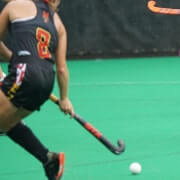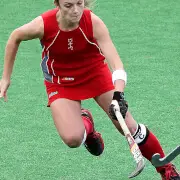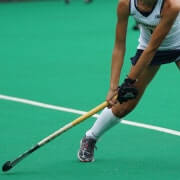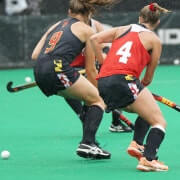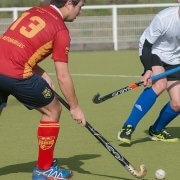How Do You Dribble in Field Hockey?
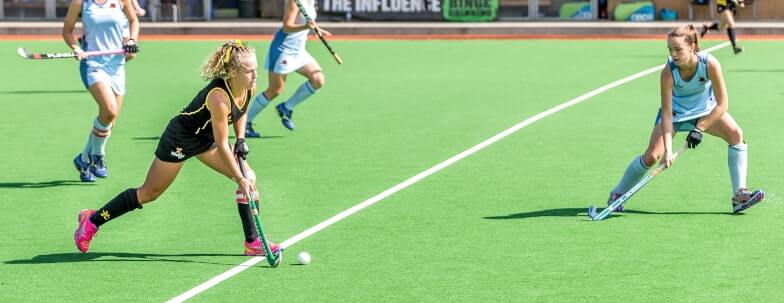
Field Hockey Dribbling
To gain field hockey proficiency takes practice, commitment, and athletic ability. What really makes you stand out, particularly professional athletes, is the ability to master basic skills such as dribbling with control, speed, and agility.
Dribbling in field hockey requires a top left-hand and a lower right-hand grip on the stick while maintaining a wide stance with knees bent and the ball one foot away, all while quickly tapping the ball to move it further down the field. This requires observation skills, ball control, speed, practice, and confidence.
This article will take a more in-depth look at how to dribble and maintain a view of the field while dribbling. We’ll also help you gain insight into crucial dribbling techniques and have you walk away with five tips to demonstrate dribbling magic on the field.
What Is Dribbling in Field Hockey?
Dribbling is a technique used in field hockey to move the ball forward using small touches with a hockey stick. While it is considered an essential skill, it is one of the most challenging skills to master, requiring a lot of practice (source).
Dribbling entails moving the ball while on the go and involves a mastery of control, speed, and constant, fluid motion. The key to dribbling is to touch the ball ever so slightly without losing control and to travel at a comfortable pace so that you can stay in stride as you move with the ball.
Dribbling enables players to pass the ball, maintain possession, and move past opponents all in the pursuit of scoring a goal. Dribbling is an essential skill in field hockey, as the game would not be possible without it.
The ability to dribble at an incredible speed, with complete control of stick and ball, makes field hockey a particularly challenging sport.
How Do You Dribble in Field Hockey?
To dribble in field hockey, and do so confidently, the player must master several essential skills simultaneously. Let’s take a closer look at which competencies are at work that you need to develop to become proficient in dribbling.
At the core of dribbling is your grip or the way you hold the hockey stick, but it is essential to note that field hockey only allows right-handed sticks (source). Left-handed players may actually have an advantage, though, using right-handed sticks (source).
Hand Placement
When dribbling, the player places the left hand at the top of the stick, which they tightly clutch, while the right hand is loosely placed further up on the grip just before the flat part of the stick. At the top of the hockey stick, the grip material enables a better hand position and hold on the stick itself.
The player must position the thumb and index finger of both hands in a V-shape and face the curved part of the stick. The player’s right hand mainly provides support and control, and it should not move on the hockey stick during the dribble.
The player uses their left hand to twist the stick, turning the stick to move the ball from left to right, doing most of the work.
Stance
The athletic body stance should use a wide base, with feet shoulder-width apart and knees bent almost in a squat position. While moving the ball, it is crucial to pivot the weight to each foot, matching it to the side of the ball on which you touch your stick.
For example, your weight should be on the left foot when the ball is on the left side and vice versa.
Ball Position
The ball position should always be away from the player’s feet at a distance of approximately one foot. The player will then flip the hockey stick’s hooked end and move the ball from one side to the other. Hold both elbows away from the body, with the left elbow bent and the right elbow extended (source).
The dribbling technique described here is also known as the straight dribble and uses the basic grip.
The Most Common Mistake
The most common mistake players make when dribbling is to fixate only on the ball without looking up to know where they are going. To ensure that dribbling does not result in the loss of possession, it is essential to scan your surroundings, maintaining a close eye on the field, while keeping track of the ball at all times.
We call this “split vision” when you simultaneously scan the field for opponents, team members, and the goal while keeping a close eye on the ball. Good vision is crucial to move the play forward and maintain possession (source).
In essence, dribbling is all about muscle memory and fluid motion. The more you spend time practicing, the more instinctive dribbling becomes. Over time, it will be as natural as walking.
We don’t even think about which foot to put first or that we have to put one in front of the other — it comes naturally.
Maintaining a View of the Field

Image by Franck Barske via Pixabay
Being able to observe the field while dribbling is a critical asset in field hockey, as in other sports, and has a significant impact on all aspects of the game. While we have already highlighted the importance of split vision in dribbling, several other factors also influence field hockey vision.
Visual Training
Because vision plays such a strategic role in field hockey, vision training programs and drills have come to the foreground in recent years. Multiple studies indicate that vision training improves field hockey players’ visual abilities and performance and should be considered a necessary training tool (source).
With a comprehensive view of the field, hockey players can make good decisions in the game context, based on what they can take in as a situation develops. Sometimes the situation might require a dribble, other times a pass. The ability to make that decision becomes more comfortable with time, awareness, and experience.
Visual Ability
Since field hockey requires excellent hand-eye coordination, it is advisable to have your eyes checked by an optometrist. This will rule out any obvious and potentially easy-to-fix issues that may be present.
Developing proper hand-eye coordination is crucial as it translates the information your eyes pick up to your body and influences body control and timing. Having the appropriate eyewear, if necessary, can be critical for depth perception. Depth perception enables players to determine distance, speed, and direction.
You will also need the ability to stay disciplined and focused. Visual concentration helps players to stay focused on the ball irrespective of distractions on the field.
Visual Skills
Proper eye-tracking limits head movement while tracking objects and facilitates quick decision-making while maintaining balance at the same time.
Dynamic visual acuity is an intricate visual skill that involves tracing a moving object while simultaneously moving your head. This competency is very complex and requires the observation and processing of information within a very short period of time (source).
Peripheral vision is critical in spotting moving objects out of the corner of your eye. This is especially helpful for goalkeepers but also when executing a lead run to the goal. It helps you keep an eye on the rest of the players.
Lastly, visual reaction time is continuously at play on the field. It is your ability to translate what you see into action. The quicker this process is, the better.
Dribbling Methods and Techniques
There are different ways to dribble in field hockey, and we’ve already examined what is termed the “straight dribble”, but there are several other methods and techniques out there.
The Loose Dribble
When employing the loose dribble, the player is continuously tapping the ball forward while running. As is the case with the straight dribble, you need to apply the basic grip to your hockey stick. The loose dribble is the perfect transition dribble and allows a player to cover ground quickly.
However, should the dribble carry you to a tight space either on the field or between opposing players, you should reduce your speed to increase ball contact and control.
The Indian Dribble
The Indian dribble first appeared at the 1956 Olympics and subsequently is tied to a few world-renowned field hockey players, such as Shahbaz Ahmed and Luciana Aymar.
The Indian dribble entails moving the ball from one side to the other while playing forward. Since you’re only allowed to use the hockey stick’s flat side, this is a lot harder than it initially sounds. The Indian dribble is one of the most remarkable offensive techniques in field hockey. It catches many opponents completely off guard (source).
The key to the successful and flawless execution of the Indian dribble lies in using the left hand to exclusively turn the hockey stick. In contrast, the right hand simply offers support.
A common error is to rotate both hands. On top of that, executing ball control and excellent vision is essential while moving the ball with the Indian dribble (source).
Dribble Pull-Back
The dribble pull-back, also referred to as a “V-pull”, is the ideal technique to shield the ball from your opponent. It combines the straight dribble with a stick rotation to the ball’s front to pull the ball back towards the dribbler’s feet.
A player using the pull-back dribble intends to confuse the opponent and throw them off guard. When executed correctly, it creates a sudden gap in the defence, allowing the player to sprint with the ball to one side, creating an imaginary V-shape.
Unfortunately, the pull-back dribble does come with heightened risk. The chances of losing the ball due to a mistimed pull-back are higher compared to other dribbling methods. Another common scenario is that the player accidentally hits the ball with their feet, resulting in a penalty (source).
One-Handed: Right Hand
The one-handed dribble is a power move in field hockey that is predominantly played on the field’s wings. It is a straight forward dribble that requires a stretched-out right hand holding the stick while keeping the ball near the hockey stick’s hook at all times.
One-Handed: Reverse Side
The same concept applies to the reverse one-handed dribble. This technique also uses only one hand outstretched and gripping the stick, but with the hockey stick’s reverse side. It really only applies to the left-wing of the field. The hockey stick is still positioned in the right hand, but now with the reverse side facing outwards.
One-handed dribbling techniques require incredible upper-body strength and control, as well as agility and grip strength.
Aerial Dribble
Aerial dribbling is a technique that supports the development of hand-eye coordination. It is not ordinarily used during a game, but it is often utilized during training and drills. This method involves continuously tapping the ball into the air with the hockey stick, balancing it on the stick hook’s flat end — it’s as simple as that.
Once you have gained some practice and experience with aerial dribbling, you can introduce aerial passes into the actual field hockey game. However, this type of technique is closely monitored by umpires due to its tendency to quickly transition into dangerous play (source).
Dribble Magic: Expert Tips to Excel in Dribbling
There are many moving parts in any field hockey game. Your ability to navigate all these variables at once will determine your fate in dribbling. However, should you wish to become an expert in dribbling, there are five things you need to know to excel and put you on the right track.
Vision
It should come as no surprise that we kick off this list with vision. To display excellent dribbling skills on the field, this is the one thing that cannot be overlooked. And vision here entails not only split vision or a bird’s eye view but also the complete comprehensive visual skill-set.
The importance of excellent vision starts from the very first moment that you touch the ball by pre-scanning the field. Once done, you will need to proceed with concentration, tracking, and dynamic visual acuity to continue your dribble streak. A great way to practice the full-on visual competencies is through juggling.
A recent study by the Department of Clinical Neurology at the University of Oxford links juggling to brain development. Memory, concentration, reaction time, reflexes, and general vision can all be improved due to juggling. As a bonus, it improves hand-eye coordination, confidence, as well as athletic ability.
Speed
The second factor at play is speed. Quick moves and non-stop movement characterize field hockey. Therefore, to excel at dribbling, you need speed. Speed requires continuous practice to facilitate neurological pathways to promote rapid decision-making in a continually changing environment.
It’s best to start slow and ensure you perfect the most basic dribbling skills in a stationary mode before introducing speed. Once you can execute them without any mistake, introduce movement and gradually increase the pace over time.
Ball Control
The speed goes hand-in-hand with the third element — ball control. Field hockey can be thought of in the following way: it is a full-speed movement with complete control of a ball in a small, confined space.
To showcase dribble magic on the field, you need complete ball control. This requires acceleration, agility, quick footwork, a solid body posture, and position.
Practice and Continuous Training
This is crucial if you want to demonstrate excellent dribbling skills in field hockey. While genetics play a vital role in the development of any sports player, practice and training are essential ingredients for success. In short, athletic performance is a result of genetics as well as training (source).
Through rigorous field hockey drills, practices, and training, you will increase speed, proficiency, accuracy, and improve ball control. The goal is to effect change in a small area, with minimum effort and maximum control (source).
Confidence
The last item on the list is confidence. It is one of the most critical factors that lead to success, yet not as easy to unpack. Like the other items on this list, confidence is a skill-set that you can develop and nurture over time. There are multiple ways you can boost your confidence.
Positive thinking enables a strong and powerful mindset that can guide you even through the most challenging times. Being prepared and pushing yourself to work hard to improve your skills are also great tools to build confidence.
Finally, controlling emotions and constructively dealing with them will help you build confidence over time.
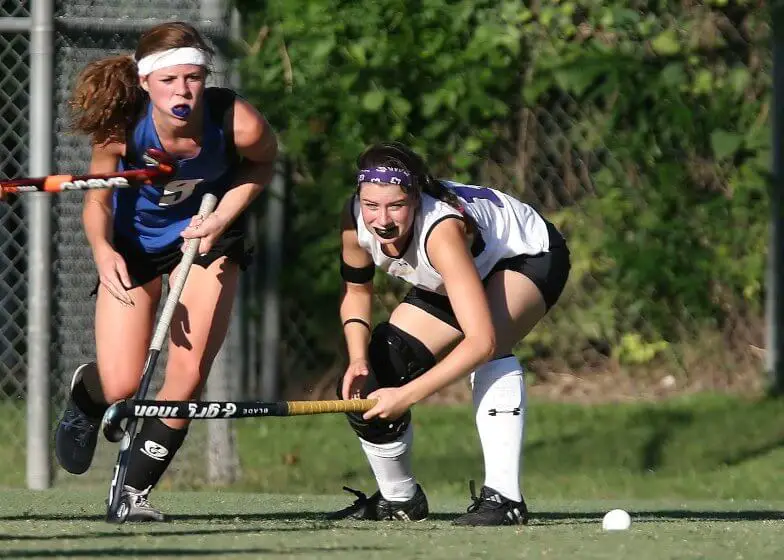
Final Thoughts
Dribbling is a deceptively challenging skill to master in field hockey. While often assumed to be a basic skill, dribbling involves a complex and varied skill-set, including competencies such as grip, body stance, and ball position. To excel at all of these at once, players require constant stimulation and practice.
Dribbling requires ball movement with full control, at high speed in tight spaces, and all while dodging opponents. To excel at dribbling in field hockey, you need to develop and nurture your vision, speed, ball control, continuous practice and training, and confidence.
